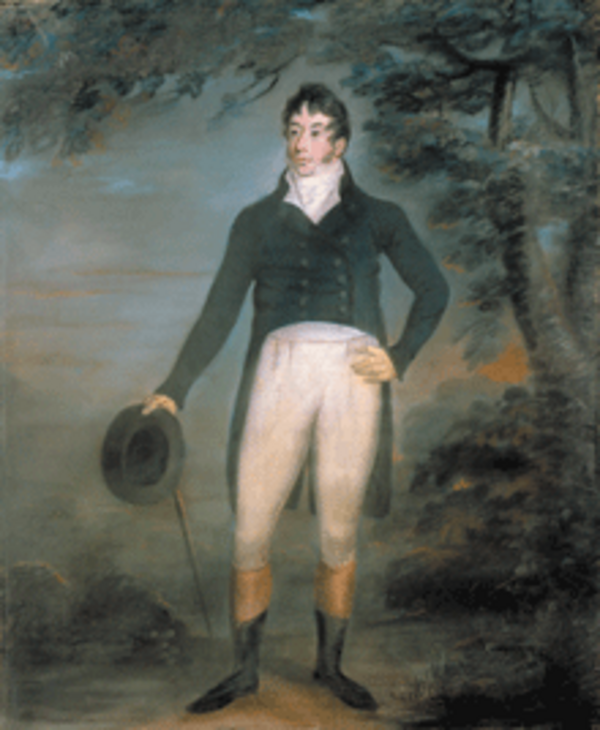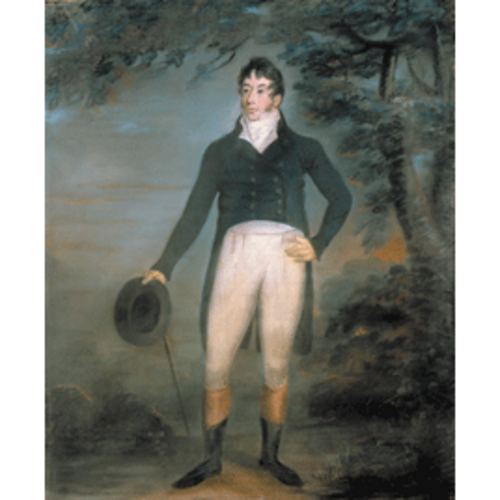
Source: Courtesy of Wikimedia Commons
McDONALD, JOHN (known as John McDonald of Garth), NWC partner and farmer; b. c. 1771 at Garth, a family estate near Callendar, Perthshire, Scotland, son of John McDonald, army captain; d. 25 Jan. 1866 at Gray’s Creek near Cornwall, Canada West. He apparently had five children by his first wife, an Indian, and six by his second, a niece of Hugh McGillis of Williamstown.
John McDonald’s withered right arm (which led to his being called “Le Bras Croche”) prevented him from following the family tradition of a career in the British army. He left for Canada in April 1791 bound to the North West Company as a clerk. Although in his “Autobiographical Notes” written in 1859 McDonald may have overemphasized his importance in the NWC, he was to participate in many of the major events of the western fur trade during the crucial years 1795 to 1814. Pugnacious and daring, he proved a valuable trader and a tenacious opponent in the struggle between the North West and Hudson’s Bay companies. Under the tutelage of Angus Shaw*, McDonald served as clerk at Moose Lake (Man.), Fort George (Alta), and Fort des Prairies. He was in charge of the building of Fort Augustus (later Fort Edmonton) in 1795 and of Rocky Mountain House (Alta) in 1799. By 1802, two years after becoming a wintering partner in the NWC, he replaced Shaw at Fort des Prairies, the largest department in the north.
After completing a furlough in 1804, McDonald wintered at Île-à-la-Crosse (Sask.), but the next season he returned to Fort des Prairies Department, where he established New Chesterfield House. Falling ill, he passed the winter of 1808 in Montreal with his sister Magdalen, wife of William McGillivray* of the NWC; elected to the Beaver Club, he amassed a huge entertainment bill. In the spring McDonald returned inland to share the charge of the Red River Department with John Wills and probably to help establish Fort Gibraltar (Winnipeg). In 1811 he carried supplies to the explorer David Thompson* in the Kootenay Range of the Rocky Mountains.
McDonald then went to England to participate in his company’s assault by sea on Fort Astoria (Astoria, Oreg.) and in February 1813 he sailed from London with Donald McTavish* on the Isaac Todd. At Portsmouth he offered a lucrative contract to a young woman, Jane Barnes, to sail with him to the Columbia, thereby bringing the first white woman to the North Pacific coast. McDonald transferred to the Raccoon in midvoyage and soon after was badly burned in an explosion. He nevertheless took charge of Fort Astoria upon his arrival 30 Nov. 1813, two weeks after an overland party of Nor’Westers had purchased the post from the American Fur Company [see Gabriel Franchère]. The Isaac Todd, with McTavish, did not arrive until 22 April 1814, 18 days after MacDonald had embarked with a brigade of about 80 Nor’Westers in ten canoes for Fort William (Thunder Bay, Ont.).
When the brigade arrived at Red River, the “Pemmican War” between the NWC and the HBC was in progress [see Miles Macdonell*]. The attempt on the part of the HBC to prevent the Nor’Westers from living off country provisions (mainly pemmican brought in by Indians and Métis), thus forcing them to import supplies from Montreal, had induced the NWC to respond by preparing to destroy the colony established by Selkirk [Douglas*]. McDonald mediated a peace between the Nor’Westers at Red River and the Selkirk colonists, but he was criticized by the NWC partners at the annual meeting in Fort William and his agreement was disavowed.
McDonald retired in November 1814 and sold his two shares in the company. He then devoted over a year to socializing in Montreal. He left Montreal early in 1816 and purchased a farm at Gray’s Creek near Cornwall. Over the years he added to his original holdings. He was active in the local Presbyterian church, and served as judge of the surrogate court of Glengarry from 1832 to 1844. Like many of his companions he adapted with remarkable ease to the sedentary life of a successful farmer. But McDonald always retained a lively interest in the west as letters he wrote to Edward Ellice and William Henry Draper* about its future development demonstrate. His autobiography, written at the suggestion of his son De Bellefeuille, recalls the highlights of the career of a spirited young man who shared the lives of great explorers and empire builders and who played a significant if not central role in the huge dramatic adventure of the Canadian fur trade. Accurate in essence if not in detail, McDonald’s self-portrait reveals the myth and perhaps much of the truth of the North West Company.
The original of John McDonald’s “Autobiographical Notes, 1791–1816” is at McGill University Libraries, Dept. of Rare Books and Special Coll. The PAC has had a copy since 1920 (MG 19, A 17). McDonald’s notes are published in Les bourgeois de la Compagnie du Nord-Ouest: récits de voyages, lettres ét rapports inédits relatifs au Nord-Ouest canadien, L.-F.-R. Masson, édit. (2v., Québec, 1889–90; réimpr., New York, 1960), II, 1–59.
McCord Museum, McDonald, A. de Lery, family papers, James McDonald to A. de Lery McDonald, 11 Oct. 1887; North West Company papers, Beaver Club minute book, 16 April 1809, 1814–16; North West Company papers, 5 July 1796–1 Aug. 1859. McGill University Libraries, Dept. of Rare Books and Special Coll., ms coll., John McDonald of Garth papers. PAC, MG 19, B1. Ross Cox, The Columbia River; or scenes and adventures during a residence of six years on the western side of the Rocky Mountains . . . , ed. E. I. and J. R. Stewart (Norman, Okla., 1957). Documents relating to NWC (Wallace). HBRS, XXVI (Johnson). [Duncan McGillivray], The journal of Duncan M’Gillivray of the North West Company at Fort George on the Saskatchewan, 1794–5 . . . , ed. A. S. Morton (Toronto, 1929). The Oregon country under the Union Jack; postscript edition; a reference book of historical documents for scholars and historians (2nd ed., Montreal, 1962), 166–68, 635–36. J. G. Harkness, Stormont, Dundas, and Glengarry: a history, 1784–1945 (Oshawa, Ont., 1946), 392, 419.
Cite This Article
C. M. Livermore and N. Anick, “McDONALD, JOHN (d. 1866) (John McDonald of Garth),” in Dictionary of Canadian Biography, vol. 9, University of Toronto/Université Laval, 2003–, accessed April 1, 2025, https://www.biographi.ca/en/bio/mcdonald_john_1866_9E.html.
The citation above shows the format for footnotes and endnotes according to the Chicago manual of style (16th edition). Information to be used in other citation formats:
| Permalink: | https://www.biographi.ca/en/bio/mcdonald_john_1866_9E.html |
| Author of Article: | C. M. Livermore and N. Anick |
| Title of Article: | McDONALD, JOHN (d. 1866) (John McDonald of Garth) |
| Publication Name: | Dictionary of Canadian Biography, vol. 9 |
| Publisher: | University of Toronto/Université Laval |
| Year of revision: | 1976 |
| Access Date: | April 1, 2025 |



